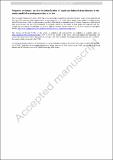| dc.contributor.author | Friesen, Emma | |
| dc.contributor.author | Hari, Kamya | |
| dc.contributor.author | Sheft, Maxina | |
| dc.contributor.author | Thiessen, Jonathan D. | |
| dc.contributor.author | Martin, Melanie | |
| dc.date.accessioned | 2025-06-16T20:18:40Z | |
| dc.date.available | 2025-06-16T20:18:40Z | |
| dc.date.issued | 2024-04-18 | |
| dc.identifier.uri | https://hdl.handle.net/1721.1/159424 | |
| dc.description.abstract | Neurodegenerative disorders, including Multiple Sclerosis (MS), are heterogenous disorders which affect the myelin sheath of the central nervous system (CNS). Magnetic Resonance Imaging (MRI) provides a non-invasive method for studying, diagnosing, and monitoring disease progression. As an emerging research area, many studies have attempted to connect MR metrics to underlying pathophysiological presentations of heterogenous neurodegeneration. Most commonly, small animal models are used, including Experimental Autoimmune Encephalomyelitis (EAE), Theiler’s Murine Encephalomyelitis (TMEV), and toxin models including cuprizone (CPZ), lysolecithin, and ethidium bromide (EtBr). A contrast and comparison of these models is presented, with focus on the cuprizone model, followed by a review of literature studying neurodegeneration using MRI and the cuprizone model. Conventional MRI methods including T1 Weighted (T1W) and T2 Weighted (T2W) Imaging are mentioned. Quantitative MRI methods which are sensitive to diffusion, magnetization transfer, susceptibility, relaxation, and chemical composition are discussed in relation to studying the CPZ model. Overall, additional studies are needed to improve both the sensitivity and specificity of MRI metrics for underlying pathophysiology of neurodegeneration and the relationships in attempts to clear the clinico-radiological paradox. We therefore propose a multiparametric approach for the investigation of MR metrics for underlying pathophysiology. | en_US |
| dc.publisher | Springer International Publishing | en_US |
| dc.relation.isversionof | https://doi.org/10.1007/s10334-024-01160-z | en_US |
| dc.rights | Article is made available in accordance with the publisher's policy and may be subject to US copyright law. Please refer to the publisher's site for terms of use. | en_US |
| dc.source | Springer International Publishing | en_US |
| dc.title | Magnetic resonance metrics for identification of cuprizone-induced demyelination in the mouse model of neurodegeneration: a review | en_US |
| dc.type | Article | en_US |
| dc.identifier.citation | Friesen, E., Hari, K., Sheft, M. et al. Magnetic resonance metrics for identification of cuprizone-induced demyelination in the mouse model of neurodegeneration: a review. Magn Reson Mater Phy 37, 765–790 (2024). | en_US |
| dc.contributor.department | Harvard University--MIT Division of Health Sciences and Technology | en_US |
| dc.relation.journal | Magnetic Resonance Materials in Physics, Biology and Medicine | en_US |
| dc.eprint.version | Author's final manuscript | en_US |
| dc.type.uri | http://purl.org/eprint/type/JournalArticle | en_US |
| eprint.status | http://purl.org/eprint/status/PeerReviewed | en_US |
| dc.date.updated | 2025-03-27T13:47:56Z | |
| dc.language.rfc3066 | en | |
| dc.rights.holder | The Author(s), under exclusive licence to European Society for Magnetic Resonance in Medicine and Biology (ESMRMB) | |
| dspace.embargo.terms | Y | |
| dspace.date.submission | 2025-03-27T13:47:56Z | |
| mit.journal.volume | 37 | en_US |
| mit.license | PUBLISHER_POLICY | |
| mit.metadata.status | Authority Work and Publication Information Needed | en_US |
